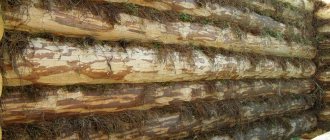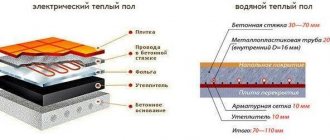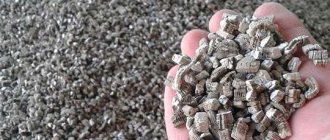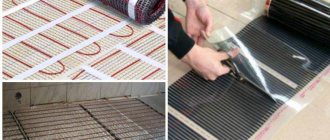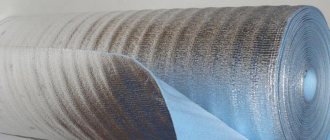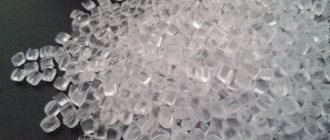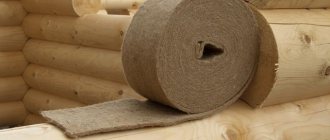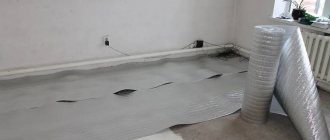In simple terms, inter-crown insulation is all types of materials used to insulate joints between logs during the construction of buildings and wood. Once upon a time, exclusively natural materials such as moss or flax were used for these purposes, which were manually filled into the cracks. Today, to insulate wooden houses, in addition to the old “old-fashioned” methods, a number of modern materials and technologies are used, and their choice depends on the financial situation of the future owner of the house and other important criteria.
Intercrown insulation
What is good insulation?
The main purpose of interventional insulation is not only to prevent heat loss, but also to create a comfortable and favorable microclimate indoors, so it must have the following characteristics:
- reliably protect the building from drafts and frost;
- have sufficient density and elasticity so that cracks do not form in it during operation;
- have good vapor permeability and moisture absorption ability;
- do not contain substances or impregnations harmful to the body;
- do not contribute to the proliferation of microorganisms and fungal spores;
- have resistance to the effects of negative factors;
- do not change its performance properties over a long period of time.
Intercrown insulation will keep your wooden house warm and cozy
In addition, when choosing an interventional beam, you should take into account the qualities and features of the material from which the building is constructed, as well as its main purpose - a residential building, a bathhouse, an outbuilding.
Insulation made from plant fibers
Jute
Jute interventional insulation
Jute is one of the most popular insulation materials today. It is made from a plant that can be found in southern latitudes. In its composition, the material is very close to wood, durable and very hygroscopic, therefore it is absolutely not afraid of moisture and can be used to insulate baths. Jute also has good decorative properties - a beautiful golden color that looks great against the background of wooden walls. It is this color that is an indicator of the quality of jute - some manufacturers add flax fibers to the material, which is why it becomes soft, grayish and significantly loses quality. This jute has a low density and cakes much faster.
Jute
Another common inter-crown insulation is the so-called “lush” jute. It attracts the attention of buyers due to its thickness and low cost. However, all the “pomp” will very quickly disappear under the weight of the building, and the connection of fibers in this case is carried out using thermal bonding using synthetic materials.
To choose the right insulation from jute fibers, you should take into account the required thickness of the material, which directly depends on the characteristics of the surface of the logs (dryness, evenness, etc.).
- For wooden houses made of glued and ordinary timber, it is recommended to use material with a thickness of 5-6 mm and a density of 400 g/m2.
- For buildings made of rounded logs, you will need insulation with a thickness of 8-10 mm and a density of 600 g/m2. You can use another option, 5-6 mm thick and 400 g/m2, which is laid in two layers.
- For log houses made of wood, it is recommended to take insulation with a thickness of 15-18 mm with a density of 800 g/m2. It is allowed to use material with a thickness of 8-10 mm and a density of 600 g/m2. in two layers.
This is what high-quality inter-crown jute insulation looks like
Inter-crown insulation made of jute is offered to customers both in the form of tapes and in the form of tow or ropes. The latter option is very popular today, as it gives the building an attractive and finished look.
Jute tow
Jute ropes
Linen
Interventional insulation made from flax fibers is cheaper than jute fibers, and has a number of advantages and disadvantages. Linen is absolutely safe for humans (sometimes it is even called healthy), quickly absorbs and releases moisture, does not accumulate static electricity and does not promote the proliferation of microorganisms. There are no hard or prickly impurities in the material, so all work can be done manually.
Inter-crown insulation flax
The most budget option is flax tow, which can be found on any construction market. Its disadvantages are that laying in this case is a rather labor-intensive process (it will have to be distributed manually, which is quite a difficult task), the material can rot, and subsequently birds can take it away. In addition, linen insulation often harbors moths, which gnaw through the material, and when performing finishing work, it can wrap around the drill.
Linen tow
A more expensive, but at the same time practical solution is linen insulation in the form of tape, since it is much easier to install, and the reliability of the material is much higher. The material can have different widths, and also does not require preparatory work - it can be laid immediately.
Hemp
Linnet - natural inter-crown insulation
Hemp is also one of the oldest materials for insulating wooden buildings (even the name of the plant itself comes from the word “caulk”) - a material called hemp is made from it. Its disadvantages are exactly the same as those of flax fiber: flammability, tendency to rot and breeding of insects.
Hemp hemp
Chemical characteristics of natural fibers
| Jute | Linen | Hemp | |
| Lignin | 12,7 | 2-5 | 3,7-8 |
| Cellulose | 64-71 | 76-80 | 74-77 |
| Pectin | 0,2 | 3 | 0,9 |
| Wax | 0,3-0,4 | 2-3 | 0,6-0,8 |
| Water | 10 | 8,5 | 10 |
| Particle length | 2-3 | 13-30 | 15-25 |
The main indicator of the strength of fibers is the content of the natural polymer lignin. This substance is contained in wood, so natural insulation materials do not destroy its structure. It promotes the lignification of cells and the formation of drainage channels (the most lignin is found in jute fibers). Pectin and wax are responsible for the elasticity and flexibility of the material: accordingly, flax has the softest fibers, and jute has the hardest.
Price for interventional insulation
Intercrown insulation
Why jute inter-crown insulation?
The result of sealing the cracks with acrylic sealant is still beautiful.
What goals do you pursue when building a house from timber or logs? Probably one of the main characteristics is environmental friendliness. Undoubtedly, there are other materials for sealing the joints between the crowns:
- flax wool;
- linen rope;
- liquid acrylic sealants;
- natural moss.
Moreover, if you choose one of the above materials, you won’t go wrong. There is no wrong option, it's a matter of taste. One of the advantages of jute over flax is that the former does not wrap around the drill. Its structure is such that when drilling, no adhesion occurs between the fibers and the metal, which is very convenient when working with insulation. Jute, produced in compliance with all standards, will last no less than a wooden house. The minimum declared service life of the insulation is 75 years.
Whether to use acrylic sealant or not is a matter of taste, but the feasibility of this approach is questionable. Of course, inter-crown joints should be non-saleable and should not allow heat to pass through, but at the same time there is a need for steam circulation. In other words, the sealant must breathe with the wood. The sealant does not have such qualities. Of course, the method is simple and fast, and the result is beautiful, but wood and sealant are completely different materials in terms of characteristics. Old-fashioned methods are more reliable and more familiar than American commercial express methods - this is dogma.
Natural materials
Sheep's wool
Inter-crown insulation made of sheep wool
The material for insulating log houses made of sheep wool appeared relatively recently, so it is not used so widely. According to the characteristics stated by the manufacturers, it does not rot, is not affected by harmful microorganisms, and is also hypoallergenic. The main disadvantages of sheep wool are its high cost and a small number of consumer reviews, since the material has been on the market for only a few years and has not yet been tested by experience.
Structure of inter-crown insulation made of sheep wool
Moss
Moss log house insulation
Moss is the oldest insulation material, which was used to caulk log houses several hundred years ago. For these purposes, two types of moss are traditionally used: cuckoo flax and sphagnum. Sphagnum contains a substance called sphagnol - it suppresses the development of fungal spores and microorganisms, and is also highly hygroscopic. Moss absorbs and releases moisture well, so it does not accumulate inside. However, preparing the material and working with it is a rather labor-intensive process. It needs to be collected in large quantities, well cleaned of branches and debris (if the moss is too dry, you can lightly moisten it with water) and placed tightly in the cracks between the logs.
Sphagnum moss
The traditional material for inter-crown insulation is moss
In order not to make a mistake when choosing natural interventional insulation, you should remember three basic rules.
- Since insulation from natural fibers is produced using the same technologies on similar equipment, cost reduction can only be achieved by using low-quality raw materials.
- Today, jute and linen materials are not subject to certification, so manufacturers themselves set quality standards. Accordingly, the characteristics of one material from different manufacturers may differ significantly.
- The fibers of a good insulation should be uniform, long enough, without any scraps of thread or twine (such impurities mean that the material was made from recycled products). A strong chemical smell is also an indicator of poor quality material.
Combined insulation materials
Interventional insulation of a combined type is made from a mixture of jute and flax or jute and felt. The fiber ratio can be 50/50, 70/30 or 80/20, with materials containing a large amount of jute being considered the highest quality. Insulation materials with the addition of large amounts of flax are prone to rotting and have low (compared to jute) heat-saving characteristics.
Lnovatin
Lnovatin
Linen wadding is a non-woven material produced in a factory using needle-punched machines. The flax fiber is combed well, folded into several layers and the fibers are mixed together with special needles. In addition, there is a quilted version of this material, which is stitched with cotton or polyester threads. Linen wadding is less dense, that is, it has fairly low thermal insulation properties. Stitching the material with threads also does not add quality characteristics to it, since cotton rots quickly. If you plan to use flax wool for insulation of wooden log houses, you should choose a material with a density of at least 500 g/m2.
Intercrown linen insulation
Felt made of jute and linen
Insulation made from a combination of jute and flax is a more reliable material, since due to the presence of jute fibers it is hygroscopic and resistant to negative factors. It can consist exclusively of flax (the so-called Euroflax), and also contain a certain percentage of jute.
Eurolen
The fiber ratio can be 50/50 or 90/10: materials with a high jute content have excellent performance characteristics, but at the same time they are quite stiff and crumbly. Flax additives bind fibers well and give them elasticity. The quality of felt is largely determined by its appearance: the material must be homogeneous, dense, without lint or broken threads.
How to choose natural and combined insulation materials?
To reduce the cost of the material, some manufacturers fluff the fibers, which significantly reduces its density. In order not to pay money for air, when purchasing inter-crown insulation, you need to take into account its main characteristics (length, width, weight), based on which the required density is calculated. It is directly proportional to the weight of the material (measured in grams) and inversely proportional to the width and length (meters). The obtained value is compared with that indicated on the packaging: with a thickness of 5 mm it should be about 400 g/m2, with a thickness of 8-10 mm - 600 g/m2, 15 mm - 800 g/m2. You should not save on purchasing insulation with good characteristics, since it is the weakest point of a wooden frame.
How much does jute insulation cost?
The price of jute insulation varies from 5.5 to 120 rubles per linear meter. Why is there such a wide spread, you ask? The fact is that a lot depends not so much on the manufacturer, but on the width of the material. So, the one that costs 5.5 rubles per linear meter has a width of 10 centimeters, while products costing 120 rubles have a width of 160 centimeters. Hence the wide spread.
The average market cost of the heat insulator described in the article is given below in table form (for the convenience of visitors).
Table. Average prices for jute insulation
Insulation with a density of 400 g/m2. The thickness of the tape is 5-6mm.
| Tape width mm. | Number of meters per roll | Number of rolls per package | Number of meters per package | Price per linear meter rub. |
| 100 | 20 | 7 or 8 | 140 or 160 | 5,5 |
| 120 | 20 | 6 | 120 | 6,25 |
| 150 | 20 | 5 | 100 | 6,25 |
| 200 | 20 | 4 | 80 | 8,75 |
| 250 | 20 | 3 | 60 | 12 |
| 300 | 20 | 3 | 60 | 14,5 |
| 800 | 20 | 1 | 20 | 37,5 |
| 1600 | 20 | 1 | 20 | 75,0 |
Insulation with a density of 600 g/m2. Tape thickness 8-10mm.
| Tape width mm. | Number of meters per roll | Number of rolls per package | Number of meters per package | Price per linear meter rub. |
| 100 | 20 | 6 | 120 | 7 |
| 120 | 20 | 6 | 120 | 8,5 |
| 150 | 20 | 4 | 80 | 9,5 |
| 200 | 20 | 4 | 80 | 12 |
| 250 | 20 | 3 | 60 | 17 |
| 300 | 20 | 3 | 60 | 21 |
| 800 | 20 | 1 | 20 | 60 |
| 1600 | 20 | 1 | 20 | 120 |
Note! Figures may vary depending on the region and manufacturer, so please check specific prices.
Synthetic materials
The performance properties of many synthetic insulation materials are inferior to natural ones, but in the range of similar materials it is quite possible to choose high-quality options. In this case, it is very important to take into account the features and purpose of the building, since the wrong choice of insulation can lead to unpleasant consequences.
Mineral wool
Mineral wool is the cheapest option, but it can be used exclusively for insulating facades. This material is not suitable as inter-crown insulation for houses made of wood (especially timber). Firstly, when compressed by crowns, it quickly loses its thermal insulation properties, and, secondly, the moisture absorption of its fibers tends to zero. The disadvantages of mineral wool are especially noticeable when insulating baths, so in this case it is recommended to choose another option.
Mineral wool is an inexpensive and practical thermal insulation material, but it is better not to use it as an interventional insulation material.
Prices for mineral wool
Mineral wool
Izover
Isover is the same mineral wool, but with improved performance characteristics. This is a popular insulation material today, which, however, has some features and disadvantages. So, in places where there is practically no gap, it shrinks greatly and loses its thermal insulation properties, but when insulating large gaps it performs its tasks well. In addition, Izover has several valuable advantages: it is not flammable, does not rot, does not attract birds, and is very easy to use. However, this modern material has one significant drawback: it is not very environmentally friendly, and at the slightest damage it releases dust that irritates the skin and mucous membranes. In the case of insulating baths, Izover also cannot be called a successful solution, as it has the ability to accumulate moisture, and in the absence of a vapor barrier, it gets completely wet.
ISOVER insulation
Polyurethane foam
Polyurethane foam is sometimes used as insulation for wooden houses, which has the following advantages:
- quick and easy to install;
- glues logs well, thanks to which they subsequently do not “creep” or warp;
- unlike moss or tow, it seals corners well;
- One-component foam does not burn and does not emit harmful substances.
Polyurethane foam
If we talk about the disadvantages of polyurethane foam, they include:
- the material is not elastic, so microcracks may appear in the wood over time;
- foam does not tolerate frost well and begins to crumble at low temperatures;
- when exposed to ultraviolet light it turns to stone and fades;
- If you compare foam with natural insulation, its environmental friendliness will be very low.
Most often, polyurethane foam for insulating log houses is used in combination with other materials, and installation is carried out in two ways.
Method No. 1. The timber is laid half a meter apart, and upon completion of the work it foams. Thanks to this, the crowns dry faster and do not require subsequent caulking. The inside walls are insulated with linen material.
Method No. 2. Before using foam, joints and cracks in the walls are sealed with tow and the building is allowed to settle well (usually this takes about a year and a half). After this, five-centimeter cracks are made in the tow, the grooves are foamed and the seams are sealed with sealant.
Sealing cracks with sealant
How to choose synthetic insulation?
If the question arises about using synthetic inter-crown insulation, it is best to focus on foreign-made materials, in particular Finnish synthetic felt. It has good thermal insulation characteristics, does not rot, does not get wet and does not contribute to the proliferation of harmful microorganisms.
Felt
New generation insulation materials
Modern insulation materials are reliable and high-quality materials that have all the positive properties of natural fibers, but at the same time have the disadvantages characteristic of flax, jute, wool, etc. they don't have. The only drawback of such materials is the fairly high cost, as well as the fact that they have not yet stood the test of time.
ThermoJUTE and thermoLEN
ThermoJUTE
Materials called thermoJUTE and thermoLEN are made from jute or flax fibers with the addition of fusible biocomponents. Under the influence of heat, they melt and firmly bind natural fibers together. Thanks to this, they keep their shape and compress well, and also retain heat well, do not accumulate moisture and do not allow the proliferation of harmful microorganisms. Laying thermo-JUTE and thermo-FLAX does not require additional insulation (caulking) of the walls after complete shrinkage of the building.
ThermoLEN - interventional linen insulation
ThermoLEN. Density 20 kg/m3
Holofiber
Holofiber is a modern polyester material, which is a springy fiber. It “adapts” well to wood, which, like any natural building material, constantly changes shape and volume. This is especially true when building houses from non-profiled timber without grooves - in this case the logs do not fit tightly together, so even after several procedures for insulation and caulking, cracks may appear in them. Holofiber ensures a tight fit of the logs, eliminating the need for repeated caulking. In addition, such insulation does not retain moisture and is not susceptible to negative factors.
Holofiber
Hollofiber® nonwoven material
Laying inter-crown insulation
Installation of insulation is an important stage of construction work, on which the strength and comfort of the future building depends. The installation technology is selected individually and depends on the processing characteristics of the logs (timber, rounded logs, etc.) and the type of insulation. In addition, there are basic rules that must be followed when installing all types of material.
How to lay inter-crown insulation correctly
- Insulation should be installed only in the warm season.
- The surface of the logs should be thoroughly cleaned and dried before performing work.
- You should not lay the material in a layer that is too thick or thin (it is important to find the “golden mean”), otherwise the logs will not settle as needed, or the walls will be constantly blown by the wind.
- The work is performed from below along the entire perimeter of the log house, first from the outside, then from the inside. The material is laid on the log, secured with a stapler if necessary, and the next log is placed on top. You cannot lay insulation on each wall separately, as in the future this threatens to distort the entire structure.
- The insulation should not roll into thin strands - its edges should protrude slightly, and after finishing the work they are pushed inside with a chisel.
Correct installation of inter-crown insulation
About a year later, after the building has given the necessary shrinkage, the procedure for laying insulation must be repeated.
About jute laying technology
The type of wall timber and its quality directly determine the method of laying the heat insulator, its thickness and the number of layers used.
Thermal insulation methods
Material laying methods.
Thermal insulating material based on jute can be placed with your own hands in the groove of logs or timber using three methods:
- lay it without bends, which is important for buildings constructed from profiled laminated veneer lumber or ordinary logs;
- installation of an insulator with double-sided bending - this solution is optimal for buildings made of rounded logs and chopped timber;
- laying the material with one-sided bending is optimal for buildings constructed from planed timber.
Below is a small instruction on what thickness of insulation to use, based on the timber of the walls.
- If the building's frame is made of laminated veneer lumber, it is necessary to use insulation having a thickness of 0.5 cm.
- If the wall material is rounded logs, use an insulator that has a thickness of 0.8/1 cm. The same insulation parameters are relevant for walls made of ordinary timber.
- If the building is constructed from chopped logs, purchase material with a thickness of 1.5 cm (
Step-by-step instructions for laying inter-crown insulation
Typically, installation is carried out in two stages: initial insulation, which is performed during the construction phase of the building, and the so-called caulk, that is, secondary insulation. It is necessary to caulk the walls at least twice: immediately after completion of construction and about a year later, after the building has completely settled.
Primary and secondary caulking of a log house
Stage one. Preparing tools
To install inter-crown insulation, a set of special tools is used, which can be purchased at any store. The main requirement is that they should not be too sharp or rough so that the blades do not cut the material or pull it out of the seams.
Caulking tools
- Flat blade. Used for sealing joints and cracks in a log house.
- Flat chisel. Necessary for sealing seams in corners and shaped elements of a building.
- Triangular caulking with a groove. With its help, rollers are formed from insulation.
- Narrow thick wedge. With this tool, narrow cracks are enlarged to make caulking more convenient.
- Wooden mallet. Needed to tightly drive the sealant into the gaps.
- Construction stapler. Fastening strip materials to logs.
- Sharp scissors.
Basic list of caulking tools
The material that will be used for insulation must be dry and packaged in airtight packaging. The exception is moss, which should be slightly moistened before work.
Stage two. Primary installation of insulation
Primary caulking of seams
The initial installation of insulation is carried out at the construction stage of the building, and the algorithm of actions is as follows.
Step 1. If tape or roll insulation is used to insulate the log house, it must be cut into strips (they should be about 10 cm wider than the logs).
Step 2. Lay moss or tow in an even layer along the entire length of the log so that the material hangs down on both sides by about 5 cm. When using tape insulation, it must be laid on the log with the same margin and secured with a stapler. The second tape is laid overlapping on top, so that there are no gaps at the joints.
Laying insulation
Step 3. After the entire row around the perimeter is covered with material, the second crown is laid on top.
Step 4. Once the entire frame is completed, you can move on to caulking. Twist a roller from the insulation and push it into the gap with caulk - it is important that it is not interrupted and is continuous along the entire length of the frame.
The principle of caulking is simple - tightly fill the inter-crown gap with a sealant
Stage three. Caulking seams
After completion of construction work and shrinkage of the building, caulking of the seams is carried out - additional insulation, for which several technologies can be used.
Caulking technique
Caulk with tape insulation
| Step, no. | Description |
| Step 1 | Stand near one of the ends of the building, place the end of the tape on the ground and move to the other end, gradually unwinding it. The tape should run smoothly, not twist or stretch, but sag slightly |
| Step 2 | Return to the beginning, lift the tape and tuck it between the crowns with a chisel or other tool (do not caulk the gaps, but lightly tuck the material). As soon as the entire wall has been passed, you should cut off the tape with sharp scissors, leaving a margin of 10-20 cm |
| Step 3 | At this stage it is necessary to caulk the wall, but do it very carefully so that the tape does not go into waves. This is done until the entire tape, along with the reserve, disappears into the gaps |
| Step 4 | Repeat all the processes described above, starting from the first stage between the same crowns (you can freely lay several more tapes there, regardless of their thickness and density). Typically, caulking walls only on the outside requires four times more material than is used for primary insulation during the construction process |
Insert insulation into the seam
After the insulation laid in the grooves becomes very dense (almost like wood), the work can be considered complete.
Selection and installation
Before you lay jute on the timber, it is important to choose the right material. It is necessary to begin insulation work only some time after the completion of the house. During this period, the wood will reach the desired level of humidity, and the walls will shrink. But even after thermal insulation, the inter-crown insulation will allow moisture to pass through, which comes from the timber or log.
Using thermal insulation, it will be possible to fill the joints to prevent the formation of cold bridges. Choosing a thicker seal will ensure ease of installation. The material should be placed in the connecting groove so that it does not move, and after it is pressed with a log, the insulation must be fixed with a stapler, installing the fasteners at a distance of 250 mm. If you purchased a ribbon that is too wide, then its edges must be folded inward. The tape should also be located in the bowls.
